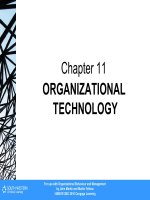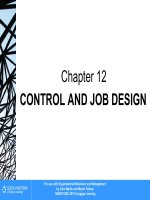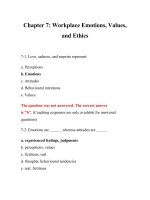Lecture Organizational behavior – Chapter 7: Leading self
Bạn đang xem bản rút gọn của tài liệu. Xem và tải ngay bản đầy đủ của tài liệu tại đây (529.33 KB, 22 trang )
7 Leading Self
Neubert & Dyck’s Organizational
Behavior
Chapter Navigator
What is Leading Self?
Knowing Self
Living Intentionally
Managing Stress and Roles
Acting Creatively
Copyright ©2014 John Wiley & Sons, Inc.
What is Leading Self?
What Does It Mean To Lead Yourself?
What is Being Authentic?
What is Authentic Leadership?
What Do Authentic Leaders Do?
Outcomes of Authentic Leadership
Leading Self and Authentic Leadership
What Does It mean to Lead Self?
What is Authenticity?
Origins of Authenticity
What is Authentic Leadership?
Examples of Authentic Leadership
Authentic Leadership
Authentic Leadership and Qualities Exhibited
Authentic Leadership and Influence on Individuals
Authentic Leadership and Outcomes for Coworkers
and Organizations
Examples of the Influence of Authentic Leadership
Knowing Self
Components of Leading Self
Outcomes of Leading Self
Relationships in Gaining SelfKnowledge
Hubris
Feedback Seeking Behavior and Structured Self
Reflection
Copyright ©2014 John Wiley & Sons, Inc.
Knowing Self and Gaining Self-Knowledge
What is Knowing Self?
Process of Gaining SelfKnowledge
Actions in Leading Self
Components of Leading Self
Outcomes of Leading Self
Copyright ©2014 John Wiley & Sons, Inc.
Hubris and Enhancing Self-Awareness
What is Hubris?
Examples of Hubris Behavior
SelfKnowledge: Conventional and Sustainable
Approaches
Feedback Seeking Behavior
Structured SelfReflection
Living Intentionally
SelfLeadership Practices
Behavioral Strategies
Natural Rewards
Constructive Thought Patterns
Calling
Self-Leadership Practices and Behaviorally
Strategies
What are SelfLeadership Practices?
Benefits (and Drawbacks) of SelfLeadership
Practices
Three Strategies to Help Live Intentionally
Behavioral Strategies
Applications of Behavioral Strategies
Copyright ©2014 John Wiley & Sons, Inc.
Rewards and Constructive Thought Patterns
Natural Rewards
Applications of Natural Rewards
Constructive Thought Patterns
Applications of Constructive Thought Patterns
Calling
Managing Stress and Roles
Stress
Workplace Stress and Stressors
Role Conflict: WorkLife and WorkFamily Conflicts
Dealing With Stress: Whole Person and Resources
Stress: Conventional and Sustainable Approaches
Stress and Work-Family Conflict
What is Stress
Examples of Stress
Workplace Stress
Role Conflict
WorkLife Conflict and WorkFamily Conflict
Copyright ©2014 John Wiley & Sons, Inc.
Dealing With Stress
Strategies For Dealing With Stress
The Whole Person
Developing Resources
Identify Applicable Situations
Breaks From Work
Acting Creatively
Creativity and Innovation
Divergent and Convergent Thinking
The Creative Process
Characteristics of Creative Individuals
Improving Creativity in Organizations
The Creative Process
What is Creativity?
What is Innovation?
Divergent and Convergent Thinking
Four Stages in the Creative Process
Implications of These Four Stages
Creativity in Organizations
Characteristics of Creative Individuals
Conventional Approach to Creativity
Five Strategies for Improving Creativity
Implications of Improving Creativity in Organizations









